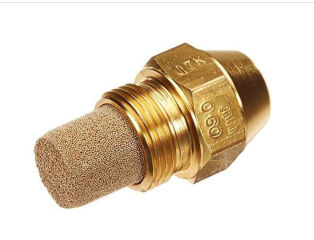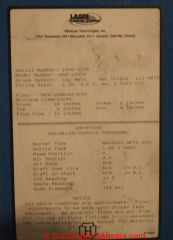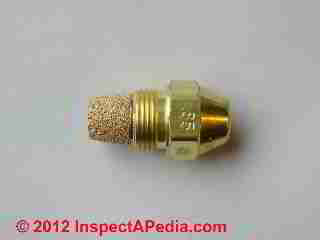 Oil Burner Nozzle Substitution
Oil Burner Nozzle Substitution
Get the right nozzle type, pattern, angle
- POST a QUESTION or COMMENT about oil burner nozzle installation
Oil burner nozzle installation & substitution
Troubleshoot an oil burner when replacing the nozzle doesn't seem to fix the problem: did we select the right oil burner nozzle?
Is the oil burner properly adjusted? What else could be wrong with the nozzle if the burner won't keep running?
InspectAPedia tolerates no conflicts of interest. We have no relationship with advertisers, products, or services discussed at this website.
- Daniel Friedman, Publisher/Editor/Author - See WHO ARE WE?
Oil Burner Nozzle Substitutions
Common Oil Burner Nozzle Subsitutions
Oil Burner Interchange Chart 1 |
|
Original Nozzle Brand |
Nozzle Spray Pattern Code |
| All Brands | Delavan or Equivalent |
| A | Del-O-Flo A |
| B | Del-O-Flo B |
| Danfoss Nozzles | |
| AS | Delavan W or B |
| AH | Delavan A |
| B | See below |
| H | |
| S | |
| EH | |
| ES | |
| Delavan Oil Burner Nozzles | |
| A - hollow | Danfoss EH, H |
| B - Solid | Danfoss ES, S |
| W - all purpose | Danfoss ES, B |
| R-D - solid, center concentrated | |
| AR-D - solid | |
| MH - Mobile Home low capacity | |
| A - hollow cone | |
| B - Del-O-Flo™ Low-Flow solid | |
| Fluidics Oil Burner Nozzles | |
| H | Danfoss H |
| HF | Danfoss H |
| S | Danfoss S |
| SF | Danfoss S |
| Hago / Sid Harvey Nozzles | |
| B - Solid | Danfoss S |
| Delavan B 2 | |
| LC - Large Capacity | |
| S-S - Semi-Solid | Danfoss EH, H/B |
| Delavan SS (up to 2.0 gph) Delavan A/W (over 2.0 gph) |
|
| ES - Extra Solid | Danfoss ES, S |
| Delavan B 2 | |
| P - Solid | Danfoss ES, S |
| Delavan B 2 | |
| Siphon Nozzle | |
| W - Universal | |
| H - Hollow Cone | Danfoss EH, H |
| Delavan A | |
| EH - Extra Hollow | |
| DFN - Dual Filtration | |
| Monarch Nozzles | |
| AR - Anti Rumble - 0.5 - 3.5 GPH Special Solid Cone Quiet operation |
Danfoss S |
| Delavan R-D/AR-D (up to 2.0 gph) Delavan A/A / W (over 2.0 gph) |
|
| HO - Heavy Oil - 1.25 - 100 GPH Use on 70 SSU Viscosity oil Pressure: 200-450 psig |
|
| HV - High Velocity - 1.65 - 60 GPH Semi-industrial & Scotch marine Narrow spray angle only, 30° / 40° |
|
| NS - 0.50 - 2.00 GPH Hollow Cone Fine Atomization |
Danfoss EH, H |
| Delavan A | |
| PL - 2.25 - 50 gph Solid up to 3.5 GPH Hollow Cone at larger GPH Extension of NS series Less fine than PLP Good where Hollow Cone specified |
Danfoss EH, H, B |
| Delavan A | |
PLP - 2.25 - 100 GPH |
Danfoss ES |
| Delavan B 2 | |
| R - 0.40 - 3.5 US GPH Solid Cone General Use Less fine atomization than NS |
Danfoss ES, S |
| Delavan R-D/AR-D (up to 2.0 gph) Delavan A/A / W (over 2.0 gph) |
|
| Scotch Marine Oil Burner Nozzles | |
| HV | Monarch HV 1.65 - 24.0 gph |
| Steinen Oil Burner Nozzles | |
| H | Danfoss EH, H/B |
| HAT | Danfoss H |
| PH | Danfoss EH, H/B |
| Q | Danfoss ES, S |
| S | Danfoss S |
| SS | Danfoss ES |
| ST | Danfoss S |
Notes to the table above
- Original sources of these oil burner nozzle cross-references & substitution table:
OIL BURNER NOZZLE SELECTION TABLE - at InspectApedia.com - standard oil burner nozzle letters, patterns, types, properties
Danfoss, PRACTICAL TIPS for OIL BURNER NOZZLES [PDF] Danfoss, retrieved 2021/06/20 original source: https://assets.danfoss.com/documents/100691/AG045286446960en-010101.pdf
Delavan, A TOTAL LOOK at OIL BURNER NOZZLES [PDF] (2000) courtesy of Delavan Fuel Metering Products [Website] a reference guide for oil burner service technicians, Delavan Spray Technologies, Fuel Metering Products Division, PO Box 969, Bamberg SC 29003, Tel: 800-982-6943 or 803-245-4347, ( Delavan is a division of BF Goodrich); web search 12/30/2010, original source: delavaninc.com/pdf/total_look.pdf
Monarch oil burner nozzles, retrieved 2024/01/30, original source: Monarch Mfg Works 7249-B Browning Road Pennsauken, NJ 08109 Phone 1 (856) 241 1500 Fax 1 (856) 324 0313 Mail info(at)monarchnozzles.com Web: monarchnozzles.com/index.php/en/applications/oilburnernozzles
- Watch out: going from Hago nozzle to Delavan A, B, or W you may need to try the next wider spray angle. E.g. go from 60° to 65° or 70°
- OPINION: Homeowner or DIY oil burner nozzle subsitutions by untrained people are inadequate and unsafe:
In substituting an oil burner nozzle brand or nozzle with other properties, the oil burner technician will start with a nozzle with the same angle, pattern type, and firing rate as specified by the oil burner manufacturer, as those are important.
She'd also clean, tune, and adjust the oil burner and if the performance and flame were good she'd stop there.
Watch out: a homeowner might be up to the mechanical tasks of changing an oil burner nozzle (though even there a mistake can strip threads, foul the burner or lead to a puffback explosion), but the homeowner, without training and equipment, absolutely can not properly fine-tune and adjust the oil burner properly
. In the old says of slow speed 1725 rpm burners we'd eyeball the flame for smokiness and spit on the flue vent connector to gauge temperature.
But with modern high speed 3450 rpm burners and often higher oil pressure operation (over 100 psi), it is not possible to properly set up the burner without measuring smoke, CO2 or O2, and stack temperature and draft in the breech and over the fire. - HV oil burner nozzles:
HV = High Velocity. HV oil burner nozzles used on commercial oil fired equipment, ONLY with a narrow angle spray pattern (30 deg or 45 deg) usually solid cone pattern. Common on light commercial installations and on Scotch Marine equipment. Noisy. - HO oil burner nozzles:
HO = Heavy Oil - used with high viscosity oils, not for residential applications. - Waste oil burner nozzles: are provided by FCT Combustion, Gencor, Goick Fuel burners ( support@ibspot.com
Tel (888) 666-8165) and Letaosk and are used for diesel, heavy waste oil including some alcohol-based fuels.
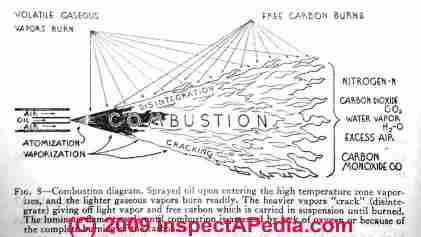 Reader Question: oil burner nozzle size and spray pattern changes or substitutions
Reader Question: oil burner nozzle size and spray pattern changes or substitutions
(Nov 22, 2012) Angela said:
Can you help I am using a 1.00/80 A tip oil burner nozzle
(Feb 23, 2013) Steve said:
My oil nozzle clogged. It was a .60 gph 70deg. spray angle [spray pattern not stated - ed]. The local store only had a .060 80deg. Is this ok to use.. the furness fired right up,,, but i don't want to do any damage,, thank you
(Mar 18, 2013) Anonymous said:
What would happen if I use a 1.25 / 80 nozzle which my 40 yr old oil burner calls for, verses a 1.00 / 80. I am trying to eliminate the short cycle and short time on which is the problem I've having now.
Would adjusting my burner thermostat to the lower end of 0.2 or the higher of 1.4 help? As you can see I'm grasping at straws looking for an answer. Thank you.
(Jan 6, 2013) Nathan said:
Can I use 1.0 80A nozzel instead of 1.0 70A? How is it effect my oil heater?
Reply:
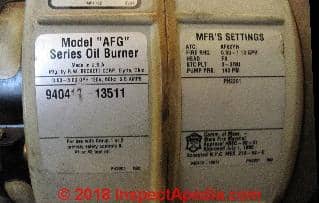 Photo: labels on this Beckett AFG oil burner include specifications for the nozzles that are expected to work properly in this unit. [Click to enlarge any image]
Photo: labels on this Beckett AFG oil burner include specifications for the nozzles that are expected to work properly in this unit. [Click to enlarge any image]
Under MFR'S SETTINGS you will find the nozzle specifications for this Beckett AFG-series oil burner:
Nozzle: 0.75 x 70 A DLVN HLW
Pump Prs: 130 psi
Anon:
- Check the manufacturer's labels on the oil burner and possibly also on the oil fired boiler or furnace to see what nozzle sizes and patterns the manufacturer recommends with their equipment. [Ilustration above].
- A small change in oil burner nozzle size -
say from 1.00 to 1.10 gph is not a serious problem but you will burn more oil and the oil burner adjustments need to be amended to fire the burner properly and safely. - Watch out: a change in the oil burner spray angle is potentially a more serious error that you seem to be avoiding - by staying with the 80 degree angle.
Changing the burner angle or spray pattern
(for example going from an A=Hollow Cone to a B=Solid Cone spray pattern or more important, going from a long narrow 60degree angle to a short wide 80 degree spray angle may make the flame size and shape no longer fit properly in the combustion chamber - leading to improper and unsafe oil burner operation. - Changing the heat anticipator
in your room thermostat has nothing directly to do with the choice of oil burner nozzle size.
See HEAT ANTICIPATOR ADJUSTMENT - Short oil burner on cycle time
can indeed be due to a too-large nozzle, but it could be due to improper control settings, burner adjustments, or other snafus too. We discuss oil burner short-cycling at
OIL BURNER WONT RUN
Check the data tag on your furnace or boiler to see what the manufacturer says is the acceptable oil burner nozzle size range that is permitted for your equipment, then call a service technician who knows how to service and adjust the system properly.
On 2018-02-26 by Mike - can't find replacement nozzle match for Burnham v-14
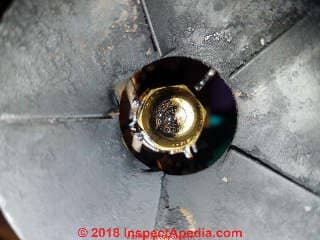 Hi, I have Burnham v-14 unit. the other day it tripped out. I changed the fuel filter and cleaned the nozzle.
Hi, I have Burnham v-14 unit. the other day it tripped out. I changed the fuel filter and cleaned the nozzle.
Couldn't find the exact replacement nozzle. It's a .75 60 degree nozzle and all I could find is a .75 80 degree nozzle.
Not sure if I can use it so i didn't put it in. When the unit does kicks on it starts and then I get a flame about 5 seconds later.
Any idea what the problem is? I did order the exact nozzle but havnt got it yet.
On 2018-02-26 by (mod) - how to get the right oil burner nozzle size (gph), pattern, and spray angle.
Mike:
First, if you haven't done so, see OIL BURNER NOZZLE GUIDE then come back to this page OIL BURNER NOZZLE SUBSTITUTIONS.
You can substitute an oil burner nozzle SIZE that's a bit larger or smaller - that's the gallons-per-hour number, or for your two examples 0.75 gph is the same on both nozzles.
You can sometimes also substitute a different specialty nozzle, like changing out a hollow-core flame (HC) for a solid core flame (SC)
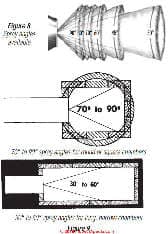 But I do NOT recommend changing the nozzle spray angle degree. If your original nozzle was 60 degrees and you go to an 80 degree you're installing a nozzle with a wider, shorter flame pattern.
But I do NOT recommend changing the nozzle spray angle degree. If your original nozzle was 60 degrees and you go to an 80 degree you're installing a nozzle with a wider, shorter flame pattern.
That might work, but it might also not: it depends on the combustion chamber design.
If you put a wide-angle spray pattern into a narrow combustion chamber then the oil spray impinges too much on the sides of the chamber, you get incomplete combustion, sooty flame, poor burner operation, and possibly a loss of heat when the nozzle clogs up from soot.
Similarly, we would not substitute a longer spray pattern (60 degree) if the original spray pattern was 80 degree - there your flame would be impinging on the back side of the combustion chamber wall.
Here's how to figure the right nozzle:
Look on the data plate for your heating boiler or furnace oil burner and at the data tag for the oil fired furnace or boiler itself. One of those, often the oil burner, will include the recommended oil burner nozzle size and pattern type.
Details about oil burner nozzles are
at OIL BURNER NOZZLE & ELECTRODES
and also in this wonderful document:
A TOTAL LOOK AT OIL BURNER NOZZLES [PDF] from Delavan, an oil burner nozzle manufaturer.
In that document you will find both nozzle cross-reference charts and also the summary table that I will paste below this comment, showing recommended nozzles for various oil burners.
We show furnace and boiler data tags
at AGE of HEATERS, BOILERS, FURNACES https://inspectapedia.com/heat/Age_Of_Heaters.php
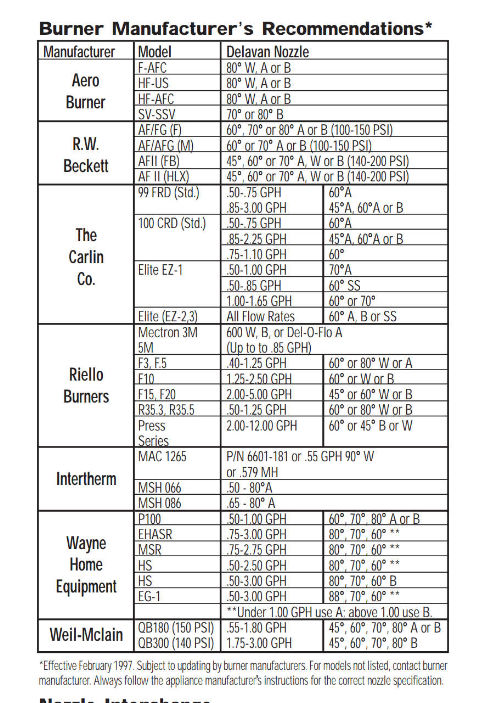 Send me photos of the data tags on your oil burner and on your Burnham heater as well as of the heater and burner itself if you can. Use the "Add Image" button next to the Comment button to attach a photo to a comment.
Send me photos of the data tags on your oil burner and on your Burnham heater as well as of the heater and burner itself if you can. Use the "Add Image" button next to the Comment button to attach a photo to a comment.
Delaval explains oil burner nozzle angles and illustrates them (pasted in below).
Generally you use a more narrow angle of say 30 to 60 degrees for a long narrow combustion chamber, and you use a wider angle oil burner nozzle, say 70 to 90 degrees for a round or short wide combustion chamber.
Besides nozzle rate or size in gph and spray angle there are various spray patterns such as solid core, hollow core, and specialty nozzles like AR - anti rumble.
The spray pattern, particularly solid vs hollow core, is matched to the air flow pattern of the oil burner itself.
On 2018-02-26 by Mike
Thanks for the nozzle info. I ordered the proper one but in the mean time I'm still having my unit trip out.
When I changed the filter it was extremely goopy.
I recently bought this home so not sure how long it went before I changed it.
Could the nozzle be clogged and cause my problems?
On 2018-02-26 by (mod) - clogged nozzle will shut down the oil burner
Mike
A clogged oil burner nozzle will certainly send to the system off on reset.
The sooty operation of the burner that happens even before that can also soot up the cad cell sensor eye.
I will copy this discussion to the key article on this topic at
OIL BURNER NOZZLE GUIDE https://inspectapedia.com/heat/Oil-Burner-Nozzle-Selection-Guide.php
Take a look at that article for more details.
On 2018-02-26 by Mike
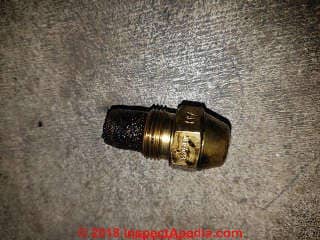 Thank you, I will wait for nozzle and hopefully that solves the issue.
Thank you, I will wait for nozzle and hopefully that solves the issue.
On 2018-02-26 by (mod) -
If you can get the right firing rate (or close to it) and angle, there are usually substitute nozzles readily available at your local heating supplier.
On 2018-02-26 by Mike
As far as the cad cell sensor, should I wipe that clean as well?
On 2018-02-27 by (mod) - cad cell sensor, should I wipe that clean as well?
Always wipe clean the face of the cad cell sensor. But also if you actually are getting more than the most miniscule amount of soot off of that surface then I think the burner is not running as clean as it should and risks loss of heat.
Search InspectApedia. for RESET SWITCH, CAD CELL RELAY - for more details. Or just hop right over to
On 2018-03-01 by Mike - dirty clogged oil burner nozzle
Well turns out it has shut off again... Any suggestions?
Put the new nozzle in just now. Old one was pretty goopy looking. What do you think Dan? Do you think this was the culprit? Cad cell was fairly clean
On 2018-03-01 by (mod) - oil burner shut down diagnosis continues
Mike
I would be looking for a source of the sludge such as taking oil from the bottom of a tank or having just got an oil delivery that stirred up sludge, combined perhaps with a dirty oil filter.
The other possibility is that sludge in the oil lines is restricting the fuel flow to your burner.
To diagnose that you need a service tech to put a vacuum gauge on the oil line. But you could open the oil filter canister and clean that out and put in a new filter.
Check the new nozzle as well to see if that's already clogged with sludge.
On 2018-03-03 by Mike
 The ends of the electrodes look burned up.
The ends of the electrodes look burned up.
So i can get it to run for a while but eventually it wont relight when it kicks on. Upon inspection The nozzle has some dark deposits on it on the top/front section where the spray comes out.
Seems like if I take out the the nozzle/electrode unit and wipe the nozzle off it will run for awhile again. Are the electrodes too close to the nozzle perhaps?
On 2018-03-23 by (mod) - scorched crud on tip of oil burner nozzle
Mike:
An improper electrode adjustment is a reasonable guess as we can see scorching on the end of the oil burner nozzle.
See the nozzle electrode specifications for your specific oil burner - usually on a tag right on the burner body.
See OIL BURNER ELECTRODES for details about the adjustment or setting of the electrodes.
Hago/Danfoss Oil Burner Nozzles Discontinued - Substitutions
The following are excerpts from an update from Beckett Corporation provided in August 2018
Hago has discontinued the 'ES' and 'P' spray patterns which have been used as 'spec' nozzles in some of our burners for quite some time. They have consolidated all solid spray pattern nozzles to their 'B' solid pattern.
... the 'B' pattern nozzle will only be available from Hago in ratings up to 6.00GPH. The 'P' pattern nozzle, popular in our line of commercial burners, will no longer be available, and there is no solid pattern nozzle above 6.00gph available from Hago.
... All specifications for nozzles above 6.00GPH will be changing to Delavan 'B' nozzles as our supply of Danfoss 'P' nozzles are depleted. All specifications for Hago 'ES', 'P', and current 'B' nozzles are being evaluated for flowrate, pattern, and performance vs. the new versions now being supplied.
See R.W. Beckett Corporation, "SUBJECT: HAGO/DANFOSS NOZZLES: MANUFACTURING CHANGES" [PDF] August 2018
Excerpts:
This change has affected their product offering for 'Solid' pattern nozzles used in Beckett and other oil burners.
Hago has discontinued the 'ES' and 'P' spray patterns which have been used as 'spec' nozzles in some of our burners for quite some time.
They have consolidated all solid spray pattern nozzles to their 'B' solid pattern.
Additionally, this has been complicated by the fact that we were more recently informed that the 'B' pattern nozzle will only be available from Hago in ratings up to 6.00GPH.
The 'P' pattern nozzle, popular in our line of commercial burners, will no longer be available, and there is no solid pattern nozzle above 6.00gph available from Hago.
RW Beckett has been extensively testing these new 'B' nozzles in various applications to assure you, our valued customers, that in performance and burner setup you will continue to get the very best combination of burner and nozzle for each specification that calls for a Hago nozzle.
...
Reader Comments, Questions & Answers About The Article Above
Below you will find questions and answers previously posted on this page at its page bottom reader comment box.
Reader Q&A - also see RECOMMENDED ARTICLES & FAQs
On 2022-01-30 by Inspectapedia Com Moderator
@Seajay,
Take a look at the diagnostic steps at
OIL BURNER WONT RUN
and let me know what you find.
On 2022-01-28 by Seajay
I have a Riello Burner on Buderus G115 with direct air intake and vented to separate flue out the chimney all to manual spec (flue size, electrode, nozzle, psi, etc)
For a few years now I've been dealing with the burner only firing on second attmpt during cold starts.
Does anyone have any ideas?
On 2022-01-18 by Inspectapedia Com Moderator
@Vince Leonard,
In my view we are discussing a WAY too much oil burner nozzle size change for a running oil fired heater to simply swap between 0.85 gph and 1.35 gph.
Speculating without proper information for your system is almost certainly going to be wrong.
Identify the oil burner brand and model and if you don't find an oil burner nozzle size range already on the burner we need to find that data.
Without that I don't know which of those nozzle sizes is far from the right one.
In general a smaller delivery rate will mean a somewhat smaller flame - with all of the obvious implications but again we are flying blind and risk smacking right into a mountain by all this speculation without data.
The problem is one doesn't know that one doesn't know important information. For example, the nozzle specifications include flow rate in GPH, nozzle spray pattern, nozzle spray angle.
Those need to be matched to the specific heating appliance including its combustion chamber size and shape.
Eg. A flame that's too big or too long impinges on the back of the combustion chamber causing improper flame, improper combstion, and over time combustion chamber damage and an unsafe heater, even risking a building fire.
It's not just a question of nozzle "size" in gph.
PLEASE read the material we've already given on this, including on the above page recommended articles list
OIL BURNER NOZZLE GUIDE
OIL BURNER NOZZLE REPLACEMENT: MATCH THE OLD ONE
On 2022-01-18 by Vince Leonard
Dear Moderator:
Thanks very much for your response. I have one more question: would using a smaller nozzle be gentler on the firebox, and conversely would a larger one cause more wear and tear? Thanks for listening.
On 2022-01-17 by Inspectapedia Com Moderator
@Vince Leonard,
I don't know enough to pretend to be smarter than your on-site service person.
However IN GENERAL it's very common to put in a smaller nozzle size in gallons per hour than the maximum that the burner could take.
Oil burners include a sticker giving the range of proper nozzle sizes intended for that oil burner.
Using a smaller nozzle is probably going to save money on heating oil cost as long as you have adequate heat capacity.
Nozzle sizes too large for the burner have a specific installation and considering the building's actual rate of heat loss nay give a very short burner on cycle and so will run less efficiently and use more oil.
On 2022-01-16 by Vince Leonard
I have a nearly 30 year old Thermo Pride furnace which has never had any problems. My long-time serviceman retired and moved away. When my new guy inspected the furnace for the first time he gave it a clean bill of health, but he said something that concerns me.
He said the firebox looked almost new, very unusual for its age, in very very good shape; and he said that although the manufacturer specs called for a nozzle 1.35 80B, what was actually in there was a .85 80B. He put the correct size in, and said that the fire would now burn hotter and use more oil.
His opinion was that the previous serviceman believed that by using the lesser nozzle he would be saving me money and extending the life of my furnace.
Is there any truth to such an idea? Was it a good idea? Should I go back to the .85 nozzle? Is it a bad idea to make the big change to 1.35 after all these years, or should the manufacturer’s instructions be followed? Thanks for listening, I would appreciate your advice.
On 2021-11-17 by Inspectapedia Com Moderator
@Mr Ian Price,
There should be a sticker right on your oil burner that gives the permitted nozzle size range for that application.
However the right nozzle is not simply based on the burner it's also based on the combustion chamber size and shape and the input rating range permitted for the heating device that you were firing.
So you might also identify the heater and take a look and it's service manual.
On 2021-11-17 by Mr Ian Price
I Have an RDB2 BF 90 / 110L Kerosene burner, what is the ideal nozzle size.
On 2021-10-25 by Inspectapedia Com Moderator
@Thomas Waldron,
There should be a sticker right on the side of the burner that gives you the range of nozzle sizes for that heating appliance.
The nozzle size in gph a function of the boiler or furnace design and size in input BTUh, not just the burner serial number.
It may also be found in the IO manual for your heater.
On 2021-10-25 by Thomas Waldron
What size nozzle do I need for Beckett burner serial number p111794386
On 2021-06-20 by Inspectapedia Com Moderator
@Kenneth,
It's certainly reasonable to go to a smaller nozzle to reduce the burner input rate and thus flame size;
Virtually all oil burners will accept a range of firing rates; your data tag simply cites a 1.00 GPH nozzle.
Take a look at your oil burner itself for any more nozzle size data.
On 2021-06-20 by Kenneth
@inspectapedia.com.moderator, Thank you very much, sir! Please see attached for the specs for the boiler and the burner.
I have another question. I use a high velocity Unico hydro-air system. My boiler at present generates too much heat for my air handlers.
I won't go into the long story of why there is a mismatch, but the net of it is that the boiler is short-cycling, i.e. it comes on for two minutes, reaches about 190F, shuts down for a minute or so until 170F, then comes on again. The heat is sufficient for the house, but the burner wears out fast because of the short cycling.
Can I change to a Delavan 0.85 60-B to reduce the amount of heat generated by the boiler?
On 2021-06-20 by Inspectapedia Com Moderator
@Kenneth,
I'm collecting our Danfoss references and will add them at the oil burner nozzle selection guide article (see OIL BURNER NOZZLE GUIDE)
and below I past in the standard Beckett AF oil burner nozzle guide - you will see that for the Beckett AFII your closest replacement for your Danfoss 1.00 gph 60-AS oil burner nozzle would be the OEM recommendations
a 60 deg. A, W, or B nozzle. That says that you can run a hollow cone, solid cone, or a W (which can replace either hollow or solid-cone) nozzle in your oil burner.
Among those you'd try first a Delavan B or a Delavan W nozzle.
Check further for a sticker right on your Beckett burner identifying nozzle preference, and post a photo of that here to help me out.
PS:
An oil burner tech would put in a nozzle with the same angle and firing rate as those are important, and she might prefer the "B" or solid cone to start. She'd then clean, tune, and adjust the burner and if the performance and flame were good she'd stop there.
Watch out: a homeowner might be up to the mechanical tasks of changing an oil burner nozzle (though even there a mistake can strip threads, foul the burner or lead to a puffback explosion), but the homeowner, without training and equipment, absolutely can not properly fine-tune and adjust the oil burner properly.
In the old says of slow speed 1725 rpm burners we'd eyeball the flame for smokiness and spit on the flue vent connector to gauge temperature.
But with modern high speed 3450 rpm burners and often higher oil pressure operation (over 100 psi), it is not possible to properly set up the burner without measuring smoke, CO2 or O2, and stack temperature and draft in the breech and over the fire.
On 2021-06-20 by Kenneth
My Beckett AF II 603 burner uses a Danfoss 1.00 60-AS nozzle, which Danfoss has discontinued many years back. I am down to my last nozzle. Is there an equivalent from Danfoss or another manufacturer I can use as a substitute?
On 2021-01-19 by danjoefriedman (mod)
Joe
Thanks for the helpful oil burner nozzle angle question;
The answer of what's the correct oil burner nozzle angle does not depend on the burner tube length nor diameter, but instead it depends on the combustion chamber design and measurements.
In general terms, a longer combustion chamber, from end of burner tube to back of the chamber towards which the tube faces, will use a more-narrow oil burner nozzle angle,
where a shorter combustion chamber will use a wider-angle oil burner nozzle spray pattern.
The manufacturer's recommend oil burner nozzle pattern type, angle, and gph rating is normally given in a stamp or sticker on the heater or burner sold with the heater.
If you don't have that information we need to identify the heating appliance and oil burner to get that information from the manufacturer, OR an oil heating tech might guess that the previously-installed nozzle was about the right one since the wrong nozzle pattern often results in malfunction, sooting, heat loss.
On 2021-01-19 by Joe Cordray
What angle nozzle would be appropriate for a burner in a six inch tube 40 inches long,
On 2020-12-19 by danjoefriedman (mod)
Typically you would leave the pressure the same
On 2020-12-19 by Maria
When changing from a .85 to a .75 gph nozzle, do you have to make any kind of adjustment in the oil pump? The heater is rated for both sizes.
On 2020-12-07 by (mod) - 3 channel 80 Degree Type S oil flow nozzle
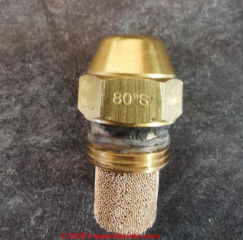 Should be no problem if we can identify the manufacturer. Is this an original oil burner nozzle? If so then he might also show us the brand and model of the heater in which it is used.
Should be no problem if we can identify the manufacturer. Is this an original oil burner nozzle? If so then he might also show us the brand and model of the heater in which it is used.
Watch out: that black muck just above the threads in your photo suggest that this nozzle may have been leaking and that a new nozzle adapter might be needed to get proper oil burner operation.
On 2020-12-07 by Steve
I have a 04 80 ° nozzle with 3 channels instead of a central delivery out of a LTS UK space heater but cant find a replacment can you help
On 2020-11-21 - by (mod) -
I'm only guessing because of course there's a lot more data that can be observed by the technician on site, but I have seen oil leaks like this when the problem wasn't the nozzle itself but the nozzle adapter or nozzle line.
If the threads on those components are damaged during installation or maintenance done or oil will leak out when the burner is running.
On 2020-11-21 by dan
the oil furnace will start up and run ok for maybe 4 to 5 hours. then will not restart. had a pm done on it by a heating co. when he came back to see whats wrong; he found the burner assy soaked with fuel he dryed it up then it ran fine.
but it kept doing the same thing and so did he. still having the same problem. do not think that the nozzle is right. renter had someone look and he changed the nozzle, old one gone
On 2020-10-26 - by (mod) -
Jody
Thank you for the question about changing the nozzle pattern and consumption rate.
On most burners you can go down to a smaller nozzle size, keeping the angle and type (angle 80 deg) (type B) the same, without trouble.
What you're doing is reducing the gallons per hour or flow rate through the nozzle from .85 gph to .65 gph.
Sometimes the tech does this in concert with setting the oil burner fuel unit pressure to a higher number. E.g. we used to run at 100 psi but the tech might go to 125 psi and then put in a smaller nozzle.
The effect is in essence NO reduction in the BTU capacity of the oil burner but an improvement in efficiency - the tech is saving you money.
So as long as the adjusted oil burner is running clean and not overheating it's perfectly fine.
On 2020-10-26 by Jody
We are tenants in a big old house with an oil-fired boiler for heat. It was serviced in January 2020 and got the OK for good combustion gases and a new nozzle, but the nozzle was a .65 80B rather than what is stipulated in the specs on the boiler, which is .85 80B. (I know all this in hindsight.)
Furnace serviced again a month ago and the nozzle was replaced, again with a .65 80B. Soon after, I started noticing soot on the top of the boiler.
Many furnace technician visits later - he got distracted by the water side of things, and so replaced the expansion tank and the P&T valve - the soot problem continued, and finally things got so bad that flames shot out of the combustion chamber and smoke poured out the side upon ignition.
We shut the unit down and a different tech came and noted that the heat exchanger and the ducts are so clogged with soot, nothing could be done about the incomplete combustion problem until we got that done.
We're now in the wait for the cleanout (and without heat), but I am wondering if the problem of incomplete combustion might be that the nozzle is not the one that the unit recommends.
I can't find info on when the heating exchange and ducts were last cleaned, so it could be that we've just reached the point where it's totally clogged, but I'm also curious about the impact of using a .65 rather than a .85 as recommended. Thoughts?
On 2020-10-19 - by (mod) -
Veronica the nozzles are both 0.65 GPH and both spray pattern "B"
There is a 14% change in the spray angle (from 70 deg to 80 deg) - not catastrophic but whether or not it makes an iota of difference in how your oil fired heater actually runs depends on the relationship between the nozzle pattern (angle is important here) and combustion chamber design. Wider nozzles run in shorter wider combustion chambers.
If a nozzle is WAY OFF (which yours is not) we can get incomplete combstion, sooty operation, and the oil burner may ultimately go off on safety reset because of flame ignition problems caused by the soot.
That may be ok - or not - check the little sticker on the oil burner that was provided by the manufacturer; typically the company gives their recommended range of nozzle sizes and patterns.
Your heating company will come out to fix the no-heat call. Ask the tech what condition she found and fixed.
Let me know what she (or he) tells you.
On 2020-10-19 by Veronica
If you have your furnace inspected and it is supposed to have a .65 70B nozzle and they put in a .65 80B nozzle Will that affect the furnace running correctly? Furnace was running very nicely then I had to have my yearly check up an inspection and now it’s not working
On 2020-10-13 - by (mod) -
Luke THanks for asking:
The difference between an A nozzle and a B oil burner nozzle is that the B produces a solid rather than hollow core spray pattern.
B nozzles are more-often used on larger or industrial oil burners. In my opinion an A nozzle will give an easier-to-set and cleaner flame in a small oil burner.
See details at OIL BURNER NOZZLE GUIDE
On 2020-10-12 by Luke
Can you show the difference between a and b angle of the nozzle
On 2020-10-13 - by (mod) -
difference between an "A" and "B" oil burner nozzleLuke Thanks for asking:
The difference between an A nozzle and a B oil burner nozzle is that the B produces a solid rather than hollow core spray pattern.
B nozzles are more-often used on larger or industrial oil burners. In my opinion an A nozzle will give an easier-to-set and cleaner flame in a small oil burner.
You're on our page about substitution oil burner nozzles. But for your Type A vs Type B oil burner nozzle question please
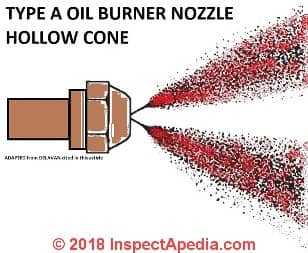 ...
... 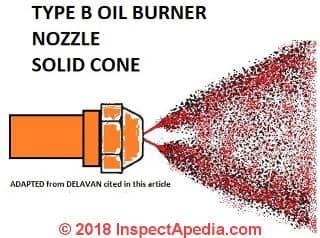
see details at OIL BURNER NOZZLE GUIDE
On 2020-10-12 by Luke
Can you show the difference between a and b angle of the nozzle
On 2020-08-21 by (mod) - wrong oil burner can cause operating problems
Artie,
Oil burners are somewhat tolerant of adjustments or changes to the oil burner nozzle as long as the nozzle size and pattern and angle are either within range of what the manufactuer specified (often by a sticker on the oil burner body) or at least close to that ranges.
But using a different-angle spray pattern nozzle than the manufacturer specifies could, nevetheless, cause harm an oil burner assembly or even to the boiler or furnace or water heater in subtle ways. Here are some examples:
The "wrong" nozzle pattern might simply be less efficient - not a catastrophe but costing you some more to operate the heating system.
But a nozzle pattern that's too long for a short combustion chamber can cause the oil spray to impinge too much on the back wall of the combustion chamber; depending on combustion chamber liner material and design that might damage the liner or the combustion chamber - in which case your service tech will be able to actually see that by inspection of the chamber, chamber liner, and the exterior of the boiler or furnacer (looking, for example for burn marks).
And an oil burner nozzle pattern that causes too much heat for the design of the boiler or furnace's combustion chamber not only wastes energy, but can overheat the oil burner assembly itself. Most often I've found this sort of blow-back overheating of the oil burner gun when there is inadequate draft over the fire. The result can push heat back up the oil burner tube where it can over-heat the ignition transformer.
A symptom of that problem is recurrent oil burner transformer failure and at least for older burners that used an oil-filled transformer, the heat can cause oil to leak out of the transformer - you'll spot it at the lower edges of the transformer or even inside the oil burner tube.
The impact of a "wrong" oil burner nozzle or wrong fuel unit pressure settings or any improper adjustment of an oil-burner for that matter, ranges from extra operating cost to damage to the equipment to, in the most-extreme cases, an oil burner puffback explosion or other safety concerns.
It's easy to get past this speculation about the impact of choosing the wrong nozzle by a careful inspection of the system by an experienced oil heat service technician.
On 2020-08-21 by Artie
I have a 1995 Energy Kinetics, System 2000, EK1, .85 Oil input gal. Beckett model AFG F3 Head oil burner it was already installed when I bought the house. I have taken care of the service since 1999 (21 years). I have used a .75 - 80° nozzle in it for at least the last 10 years.
Problem is everything I read specs a .75 - 70°, the pump pressure is 130 psi as required. I'm not sure if I or someone before me put the wrong nozzle in years ago.
Has this been harmful to the oil burner , and can I switch to the recommended nozzle without an issue. I do not have the proper test equipment for co 2 settings etc. and you can not see the flame in the type of burner. Thanks for any help.
On 2020-03-08 - by (mod) - What nozzle "size" in gph, can I install on the oil burner
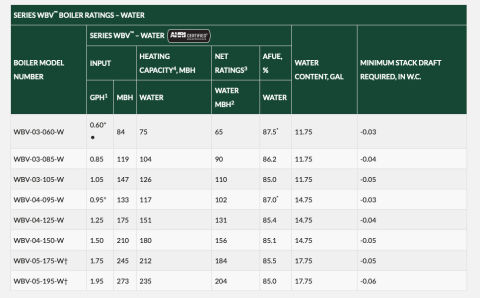 Anthony,
Anthony,
The "size" in gph, that you can install on the oil burner for an existing boiler or furnace depends on several variables.
[Click to enlarge any image]
The oil burner typically wears a sticker giving the manufacturer's recommended nozzle pattern, angle, and gph rating for a specific fuel unit pressure setting. It's common to vary a few decimal points up or down in gph around that or sometimes to up the pressure and drop the gph to avoid over-firing the burner.
But nobody can give a "right" answer without checking with the specific burner and its IO manual and manufacturer's specs.
The "WBV-04" that you cite is probably referring to a Peerless WBV series residential hot water or steam boiler .https://www.peerlessboilers.com/products/series-wbv/
Excerpt:
The Series WBV™ residential, oil-fired boilers are available for use with both hot water and steam systems and designed for natural draft (chimney) venting. The fully-packaged or knockdown boilers are available in 3 sizes (3-5 sections) with 8 firing rates.
Features of the Series WBV™ boilers include a full plate swing-out door and convertible rear to top flue outlet (for 3 and 4 section boilers only). Water boilers include Taco circulators and HydroStat reset controls with low water cut-off. Steam boilers include Honeywell operating controls and probe type low water cut-offs.
A deluxe, insulated enameled steel jacket on all boilers reduces heat loss. The cast iron sections are assembled with steel push nipples and factory tested to assure a water tight seal.
So you see there's more than one boiler size (from 84 to 273 MBH Input) and thus of course more than one oil burner nozzle size that might be correct. CHECK your boiler's data tags and IO manual.
Shown below: the oil burner firing rates for the series of Peerless WBV-series boilers with a Carlin oil burner.
On 2020-03-06 by Anthony
What size nozzles can you put in a wbv-04
On 2020-01-03 - by (mod) -
Duane
Typically you would stick with the same spray pattern and nozzle flow rate as the service tech has already installed on your oil burner.
If you're getting a carbon or soot build-up it's more likely that the flame needs to be adjusted and the system cleaned.
You should realize that proper cleaning and tuning of an oil burner is no longer something that a homeowner can really get right. In addition to training you need equipment to measure draft, CO2, smoke level, and temperature.
On 2020-01-02 by Duane Burgess
Have a. 60 80 degree B nozzle now, building up carbon, what size do I need to get?
On 2019-11-30 - by (mod) -
Jack,
The best source for selecting the proper oil burner nozzle spray pattern and type and size is data that usually found on a tag or decal right on the oil burner.
The same day to maybe in the oil burner service manual. In addition several of the oil burner nozzle companies such as Delavan and Monarch provide a book listing a huge number of oil burners and recommended nozzle ranges.
If your oil burner is not going to give you the day to you need and you can't find or paying the proper manual then you may be stuck with choosing a general-purpose nozzle that usually works as a starting point.
As you will read in this article series, the nozzle parameters include
the flow rate in gallons per hour,
the spray angle which determines whether the flame is short medium, or long to match the shape of the combustion chamber,
and a spray pattern such as solid or Hollow or anti Rumble.
Corn existing system that's been in use I would expect to find an oil burner nozzle already in place and I would examine that won against the data available. Most likely the existing arousal is the same as the one I would start with when installing a new oil burner nozzle.
If I had absolutely none of those data sources available, which would be odd, I would still have to inspect the combustion chamber to see its dimensions and based on that select an appropriate nozzle spray angle and nozzle flow rate range suitable for the heating equipment. With those two data points I might start with a hollow cone nozzle if I knew nothing else.
Online your heating service tech is needed to help you. Although the mechanics are not complicated proper setup of an oil burner nozzle requires both training and special equipment that are not in the hands and minds of a normal homeowner.
On 2019-11-30 by Jack
What is the proper nozzle for Crane Co. oil boiler model A3? Range .75 to 1.35.
On 2019-10-27 - by (mod) -
Ralph
IN any event if the oil burner flame is smoky the system needs adjustment and perhaps tuning, regardless of a change in oil burner nozzle size.
So yes, call for service.
On 2019-10-27 by Ralph
What should I do --call them again---it was not that way when it had the smaller nozzel
On 2019-09-15 - by (mod) - possible causes of a smoky flame after installing a new nozzle.
Dale
There are several possible causes of a smoky flame after installing a new nozzle.
The step down in size would not itself explain "wet" unburned fuel nor smoky flame in the combustion chamber.
I'd look for
- damaged nozzle adapter: stripped threads, cross-threading, leaks when the burner is on
- wrong pressure setting at the burner fuel unit (oil pump)
- wrong electrode setting or cracked damaged electrodes
- wrong combustion air setting
- wrong draft setting
- clogging in the fuel system, intermittent starving, bad flam
- damaged/ bad fuel unit
- something else I've not thought-of .
Watch out: a normal homeowner can not properly set or adjust a modern high-speed oil burner. You need training and you need equipment to measure draft and stack temperature (perhaps also CO2). You need a trained service tech.
Watch out: also - as you can read in the ARTICLE INDEX - for PUFFBACK EXPLOSION risk that can occur when an oil burner is not burning properly.
On 2019-09-15 by Dale Cowle
My oil furnace called for a .85 70d nozzle but when I changed the nozzle it had a .75 70d one and it was wet. After starting, it seemed a bit smoky in the combustion area. Would the furnace be set for a .75 differently to make it a bit smoky (not thru the vents. I noticed this when I took a peek to see it burning) or because it was wet could it be because a bit of unburnt oil?
On 2019-09-17 by (mod) -
Posting from promotional email received from Beckett:
R.W. BECKETT ANNOUNCES ADVANCED RENEWABLE FUEL BURNER SOLUTIONS
[R.W. Beckett is ] pleased to announce that the popular R.W. Beckett AFG burner will be rated for R95+ fuel, which is a 95% renewable diesel, by 2020. This new capability enables communities, fuel dealers, and service technicians the fastest pathway to a net zero carbon solution for the heating industry.
Initial adoption is anticipated in the Pacific Northwest, Western Canada, and select areas of the Northeast in 2020. This new line of oxygen-free renewable diesel (R95) burners will only require a modest upgrade to the existing installed base and will be supported with current warranty coverage.
We see renewable diesel as a breakthrough that offers oil heat the lowest carbon footprint option available and creates a bright and sustainable future for liquid fuels within the heating industry. This combination of renewable diesel and biodiesel fuel burner solutions from Beckett provides a green solution for the market regardless of your choice in sustainable fuels.
On 2019-09-15 by (mod) - causes of a smoky flame after installing a new nozzle.
Dale
There are several possible causes of a smoky flame after installing a new nozzle.
The step down in size would not itself explain "wet" unburned fuel nor smoky flame in the combustion chamber.
I'd look for
- damaged nozzle adapter: stripped threads, cross-threading, leaks when the burner is on
- wrong pressure setting at the burner fuel unit (oil pump)
- wrong electrode setting or cracked damaged electrodes
- wrong combustion air setting
- wrong draft setting
- clogging in the fuel system, intermittent starving, bad flam
- damaged/ bad fuel unit
- something else I've not thought-of .
Watch out: a normal homeowner can not properly set or adjust a modern high-speed oil burner. You need training and you need equipment to measure draft and stack temperature (perhaps also CO2). You need a trained service tech.
Watch out: also - as you can read in the ARTICLE INDEX - for PUFFBACK EXPLOSION risk that can occur when an oil burner is not burning properly.
On 2019-09-15 by Dale Cowle
My oil furnace called for a .85 70d nozzle but when I changed the nozzle it had a .75 70d one and it was wet.
After starting, it seemed a bit smoky in the combustion area. Would the furnace be set for a .75 differently to make it a bit smoky (not thru the vents. I noticed this when I took a peek to see it burning) or because it was wet could it be because a bit of unburnt oil?
On 2018-12-09 by (mod) -
Anon
I would be looking for a problem with the oil burner electrodes or the Transformer itself.
On 2018-12-04 by Anonymous
floods out and will not fire up
Question: Every time my oil furnace fires I can smell raw heating oil/diesel smell from my chimney.
Every time my oil furnace fires I can smell raw heating oil/diesel smell from my chimney. It may last up to 5 minutes. No smell in the house. The furnace gets serviced every year,new filter,new nozzle and cleaned. - Joe. 10/10/11
Reply: Improper oil burner operation, unburned oil, or bad draft - watch out for a puffback
Joe,
I agree that you should not smell heating oil when the equipment is running. Because you describe the smell as not continuous, just at start-up, I suspect a dirty system that needs cleaning and service. Or you could have a dirty chimney and bad draft.
Most likely you've got a system that is not running properly and is stinking up things at start-up. Once strong draft is established and the system is up to full operating temperature (typically 5 minutes), the draft improves and combustion may improve enough to keep going. But the system is not running properly.
Watch out: if this condition continues the risk is a puffback that can damage the equipment and blow soot around the building.
A blocked or dirty chimney or lack of combustion air or other causes could be present - ask your heating service company manager to send a technician who will diagnose and fix the problem. It sounds as if the usual annual service procedure has not been sufficient.
That's no surprise. During the heating season the techs are overworked and over committed and sometimes will just clean the system without taking the time to diagnose an actual problem and fix it.
Question: Sometimes my oil burner won't re-ignite
I have an aero burner on my hot water furnace. Starts and runs perfect most of the time. Every once in a while it will not re-light I press the reset button, it might run perfect for a week or two, then one day it will not light Press button again,starts right up and runs perfect, maybe for two days or two weeks again, then all of a sudden it will not light Any suggestions what to look for. - Joe Daye 12/3/11
Reply:
Joe, take a look at the oil burner diagnostic suggestions beginning
at OIL BURNER INSPECTION & REPAIR. Usually when a system is limping along as yours is described, the operating problem is going to get worse. I'd look for an air leak in the oil piping, a dirty oil burner, a clogging filter, a draft problem.
Question: I kept my oil furnace running for two hours - would that damage the electrodes or transformer?
I kept the oil furnace running continuous for about two hours, then it stopped running by itself. I pushed the reset on the stack control, it ran for a few seconds then kicked off. Did I burn out the electrodes or transformer by running it non stop? - Bob 2/9/12
Reply:
Bob:
No. Running a furnace non-stop for two hours should not itself damage the equipment. On the coldest windiest day of the year in a poorly insulated home an oil burner might run almost continuously for hours. Something else is wrong.
Question: Our oil burner only ignites if the door is open. What might be wrong.
We have replaced the electrodes and nozzle on the furnace. It will only light with the door open and stay going after you close the door - seems like it is not getting enough air. What could be the problem? - Simone
Reply:
If you mean that the door to the boiler room (or furnace room) has to be open for an oil burner to work, that suggests it's air starved - we need about 1 sq. in. of air intake into a small utility room per 1000 BTUH for oil fired heating equipment - so a 90,000 BTUH oil heater would need 90 sq. in. of unfettered air intake opening.
If you add louvers and screening the sq. in. requirement is increased.
Take a look at COMBUSTION AIR REQUIREMENTS
and COMBUSTION AIR for TIGHT BUILDINGS
But lack of combustion air usually leads to sooty operation and the oil burner going off on reset, or worse, loss of heat.
The bit about "... stay going after you close the door " is baffling. If we don't have enough combustion air to ignite then we shouldn't have enough combustion air to keep going.
I figure you need a service call from an expert heating service tech who will check the condition of the burner, combustion air setting, cleanliness of the flue vent connector and chimney, the draft, and a few other parameters.
Question: oil burner runs continuously, won't stop, doesn't fire-up
(Jan 16, 2013) Burner Runs continuously without said:
hi,my burner wen started up it runs constantly without any change,no attempt off fire or ignition!!would this be electrodes??
Reply:
Watch out: turn off the system immediately. When a fuel unit keeps pumping oil into the combustion chamber without ignition, later ignition can cause a dangerous puffback explosion. (OIL BURNER SOOT & PUFFBACKS )
It sounds as if your oil burner safety controls are not working or have been bypassed. This is an unsafe heating system that needs repair by a trained service technician.
Question:
5/20/2014 NATHAN said:
Anyone know what can goes wrong with the valve in the oil gun assembly and where can I buy the gun assembly with the valve and the nozzle adapter?
Reply:
Nathan
Armed with the brand and model of oil burner you could certainly buy an entire assembly, even the burner tube, and replace those parts, but before considering that I'd look for normal maintenance replacements instead.
The usual parts that are replaced are the electrodes if the ceramic is cracked or damaged, and of course the nozzle at annual service.
If someone heavy-handed has worked on the system and over-torqued the nozzle into the nozzle adapter there could be damage and leaks at the nozzle adapter or at the connection of the adapter to the oil tube.
The turbulator, if your oil burner gun has one, is cleaned but rarely would need replacement.
Question: soot out of the damper - is that a problem?
(Sept 21, 2014) Anonymous said:
I have an old Brock engineer oil furnace and black soot comes out of the damper on the floor. Is that normal?
Reply:
Richard, it sounds like an oil burner clean out and tuneup are needed along with a chimney and combustion air check.
Watch out: be sure to read OIL BURNER SOOT & PUFFBACKS
Question: use Beckett brand oil burner electrodes in an Aero oil burner?
(Dec 22, 2014) Lloyd said:
I have an Aero burner, can Beckett brand electrodes be used in this burner?
Reply:
Lloyd
I think that you're ok as long as the electrodes, including the metal electrodes themselves and the ceramic insulators and their end connectors that marry the oil burner transformer power supply contacts are in all regards the right dimensions.
Question: hot water heater oil burner keeps turning on and off when it first fires
(Jan 14, 2015) Anonymous said:
my hot water heater oil burner keeps turning on and off when it first fires. It will then stay running after that. A couple times it tripped out
Reply:
Check the diagnosis above at CONTINUE READING titled
There could be simply a loose wire, or the oil burner may simply need service. Don't let it go too long. The risks include loss of heat or a puff back.
Question: I changed the nozzle on my oil burner but it still won't fire up
(Jan 15, 2015) Anonymous said:
i changed nozzle and it still wont start up
Reply:
See the diagnostics at OIL BURNER WONT RUN
(Dec 3, 2012) John said: By the way Nice Site....
Continue reading at OIL BURNER NOZZLE GUIDE - home, or select a topic from the closely-related articles below, or see the complete ARTICLE INDEX.
Or see these
Recommended Articles
- OIL BURNER ELECTRODES - how to set the electrodes on the oil burner once you've got the right nozzle
- OIL BURNER RUMBLING NOISE
- OIL BURNER NOZZLE GUIDE
- OIL BURNER NOZZLE REPLACEMENT: MATCH THE OLD ONE
- OIL BURNER NOZZLE FIRING RATE GPH
- OIL BURNER NOZZLE SPRAY ANGLE
- OIL BURNER NOZZLE SPRAY PATTERN
- OIL BURNER NOZZLE DROPLET SIZE RANGE
- OIL BURNER NOZZLE SELECTION TABLE
- OTHER OIL BURNER NOZZLE FEATURES
- OIL BURNER NOZZLE SUBSTITUTIONS
- OIL BURNER NOZZLE GUIDE BOOKS
- OIL BURNER INSPECTION & REPAIR - home
- OIL BURNER WONT RUN help diagnosing and fixing oil burners
Suggested citation for this web page
OIL BURNER NOZZLE SUBSTITUTIONS at InspectApedia.com - online encyclopedia of building & environmental inspection, testing, diagnosis, repair, & problem prevention advice.
Or see this
INDEX to RELATED ARTICLES: ARTICLE INDEX to HEATING OIL, OIL BURNERS, OIL FIRED HEATERS, OIL TANKS
Or use the SEARCH BOX found below to Ask a Question or Search InspectApedia
Ask a Question or Search InspectApedia
Try the search box just below, or if you prefer, post a question or comment in the Comments box below and we will respond promptly.
Search the InspectApedia website
Note: appearance of your Comment below may be delayed: if your comment contains an image, photograph, web link, or text that looks to the software as if it might be a web link, your posting will appear after it has been approved by a moderator. Apologies for the delay.
Only one image can be added per comment but you can post as many comments, and therefore images, as you like.
You will not receive a notification when a response to your question has been posted.
Please bookmark this page to make it easy for you to check back for our response.
IF above you see "Comment Form is loading comments..." then COMMENT BOX - countable.ca / bawkbox.com IS NOT WORKING.
In any case you are welcome to send an email directly to us at InspectApedia.com at editor@inspectApedia.com
We'll reply to you directly. Please help us help you by noting, in your email, the URL of the InspectApedia page where you wanted to comment.
Citations & References
In addition to any citations in the article above, a full list is available on request.
- Beckett Corporation, 38251 Center Ridge Rd., North Ridgeville, OH 44039 440-327-1060 Email: sales@beckettcorp.com supplies residential and commercial oil burners for boilers, furnaces, and water heaters - see www.beckettcorp.com/
- Domestic and Commercial Oil Burners, Charles H. Burkhardt, McGraw Hill Book Company, New York 3rd Ed 1969.
- In addition to citations & references found in this article, see the research citations given at the end of the related articles found at our suggested
CONTINUE READING or RECOMMENDED ARTICLES.
- Carson, Dunlop & Associates Ltd., 120 Carlton Street Suite 407, Toronto ON M5A 4K2. Tel: (416) 964-9415 1-800-268-7070 Email: info@carsondunlop.com. Alan Carson is a past president of ASHI, the American Society of Home Inspectors.
Thanks to Alan Carson and Bob Dunlop, for permission for InspectAPedia to use text excerpts from The HOME REFERENCE BOOK - the Encyclopedia of Homes and to use illustrations from The ILLUSTRATED HOME .
Carson Dunlop Associates provides extensive home inspection education and report writing material. In gratitude we provide links to tsome Carson Dunlop Associates products and services.


